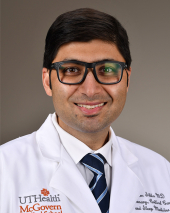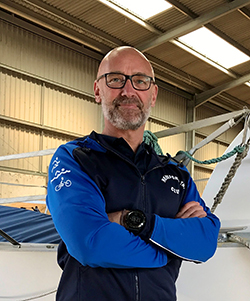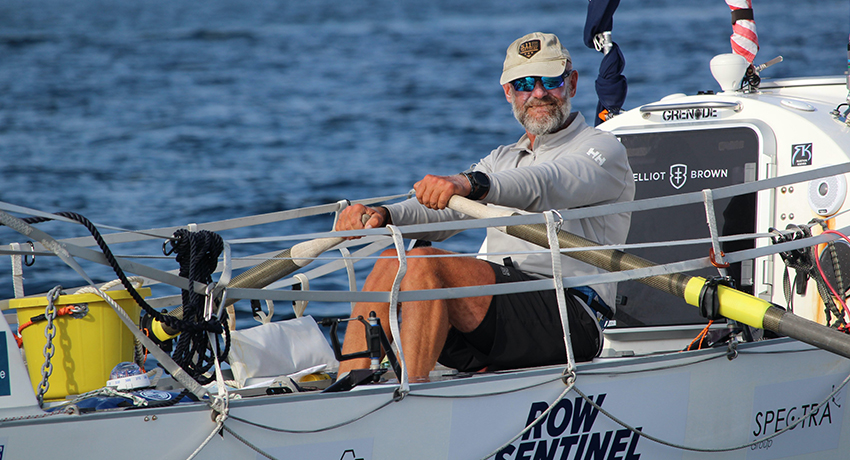Extreme athlete doesn’t begin to describe Ian Rivers. At 58, his accomplishments read like a script in an adventure movie: climbed Mount Everest, swam the longest river in England, and was the 16th person in the world to complete the Enduroman Arch 2 Arc triathlon, a nearly 500-mile run/swim/cycle endurance challenge from England to France. Most recently, he rowed 3,100 nautical miles solo across the North Atlantic for 85 days with only celestial navigation from New York City to the tip of England in 2021.
But Ian knew something was wrong in 2022. His body was misfiring, he said, despite all the physical and mental training he had completed for his high-risk adventures, which pushed his body to the limit.
“I would get to a certain training zone, which wasn’t particularly hard, and my heart rate would just race off,” Ian said.
Discovering sarcoidosis
An emergency room visit in January 2023 revealed nothing was wrong with his heart. Doctors discovered low cortisol levels, which can be a precipitating factor for autoimmune diseases. Ian later visited a neurologist and a cardiologist in New York because his condition didn’t improve.
After a complete cardiac evaluation, the cardiac MRI showed signs of swelling or scarring. This was the first sign he might have sarcoidosis. This misunderstood condition is a multisystem disease that causes small swellings throughout the body that eventually cause organ dysfunction. An X-ray revealed swollen lymph nodes, typically seen in sarcoidosis. A biopsy revealed the swelling was a non-necrotizing granuloma, a cluster of noncancerous white blood cells that cause lumps.

How did a British man splitting time between England and New York end up with a Houston specialist? A cardiologist friend of Ian’s in Houston emphasized the high level of care found in the Texas Medical Center. Ian became connected to Gautam Sikka, MD, a pulmonologist at UT Physicians Internal Medicine – Texas Medical Center, eight months after his first symptoms appeared.
“The trail led to Dr. Sikka,” Ian said. “We did a barrage of tests over a period of time to get the full diagnosis. He wanted to bring all the disciplines together, which was one of the things that was particularly good at UTHealth Houston.”
Navigating a solution
“Being an athlete and expected to have a low resting heart rate, Ian was experiencing tachycardia with minimal exertion,” said Sikka, assistant professor with McGovern Medical School at UTHealth Houston.
Sikka did his own thorough evaluation during Ian’s August 2023 visit. While they knew he had pulmonary sarcoidosis, his team in New York didn’t explain he had cardiac sarcoidosis. Only 3% of people have cardiac involvement with scarring on the heart. Sikka also wanted to rule out eye and nerve involvement, so he ensured Ian saw the right physicians within the UTHealth Houston sarcoidosis multidisciplinary team.
Ian went through further imaging and another biopsy, and his sarcoidosis diagnosis was confirmed again. Sikka also ordered additional lab work to explore Ian’s vitamin D levels to check for hypercalcemia. Sometimes the granulomatous inflammation in the lymph nodes can produce an enzyme that makes its own active form of vitamin D. Sikka determined that Ian’s vitamin D levels were elevated. His active sarcoidosis was not just related to his lungs but also was causing a metabolic abnormality.
Understanding the numbers

Ian’s training levels in the past resembled a semiprofessional athlete. Training could range from an hour to eight hours a day, depending on the required training load for his next adventure. Ian gradually found his lung capacity, VO2 max, dropped dramatically to correlate to an average person his age. Ian’s normal VO2 max was anything but average.
“I know I’m not as fit as I was because I’m not doing all that training, but you don’t lose it all,” Ian said. “Dr. Sikka is one of those doctors that gets it. And he said it’s unusual for someone like me to have sarcoidosis.”
Ian admits he might not have noticed the change in his breathing if he wasn’t as physically active and pushing his body into the higher zones.
“Normally, the heart rate didn’t rise off, but made a linear curve of effort to heart rate,” Ian said. “I would get to midrange and struggle for breath.”
After a few minutes, his heart rate would go down, and his breathing would go back to normal. His lungs might feel tight and take 30 minutes to feel normal.
Designing sarcoidosis treatment
Ian went from long endurance events that tested his resilience and mental fitness to hitting a speed bump with sarcoidosis. Sikka continued asking questions to learn if sarcoidosis also affected his eyesight and nerves. Ian said all of this was necessary to get to a treatment plan.
Sikka prescribed steroids to suppress Ian’s immune system. His vitamin D levels dropped, which emphasized that his active sarcoidosis was related not only to his lungs but also to a metabolic abnormality. For now, his treatment includes the minimum effective dose of steroids. Ian will later transition to a steroid-sparing agent to minimize the long-term side effects of steroids.
“When we see someone having a lung and heart abnormality along with the hyper vitamin D, we know these patients require longer-term immunosuppression,” Sikka said.
While Ian thrives on the unknown with his adventures, his challenge with sarcoidosis is not knowing when it’s going to go away. He finds his lungs are working better four months into treatment. He describes it as achieving better numbers, such as running faster for less effort.
“For me to know it’s working, I have to go out and train because that was the key marker that I knew I had it,” Ian said. “Dr. Sikka wants feedback on whether I’m actually getting my fitness and lung capacity back to where it should be.”
Relying on a team for sarcoidosis expertise
Sikka praises the benefits of using a multidisciplinary team to treat sarcoidosis. The disease can affect the lungs, kidneys, heart, brain, bones, skin, and eyes. When Sikka first arrived at UTHealth Houston two years ago to begin the sarcoidosis program, he met individually with each expert. He explained that patients need comprehensive, multidisciplinary care, and he believed that they would be vital to that vision.
“We have a group of people we can confer with, and that’s the kind of confidence I want to give my patients,” Sikka said. “It’s a rare disease with rare manifestations, and sometimes even we don’t have the answers.”
Dr. Sikka brought all the medical disciplines together to get the big picture first, which for me, mentally, was like the Gold Star approach.
– Ian Rivers, sarcoidosis patient
The team comprises 16 specialists, including a cardiologist, pulmonologist, endocrinologist, bone health expert, and more. They meet once a month to discuss challenging cases. Sikka’s staff coordinates with and calls other specialists to help move patients through the process.
“Our goal is to decrease patient wait times and make it more efficient for them,” Sikka said. “And at the same time, educate them. Half of my time during visits goes into educating patients.”
Ian certainly trusts and values Sikka’s expertise in sarcoidosis to travel nearly 5,000 miles for various appointments. He describes him as a doctor who inspires confidence.
“He’s a subject matter expert on sarcoidosis and, most importantly, he explains it in layman’s terms,” Ian said. “He doesn’t try to overcomplicate it. And he’s incredibly flexible for me spending half my time in England.”
Treating with precision
Sikka said he often treats the consequence of sarcoidosis. These are patients who come to him with sarcoidosis but have never been treated for it. They are oxygen dependent, as a result.
When patients don’t connect with an expert in sarcoidosis, Sikka said other physicians could prescribe too much immunosuppression, which is the greatest possibility. The other possibility is not getting enough immunosuppression.
“This is the worst case because they will lose lung and heart function,” Sikka said. “They also may develop hypercalcemia, which can lead to kidney injury, kidney stones, fatigue, and skin issues, as well as cardiac abnormalities.”
As part of the peer review committee with the Foundation of Sarcoidosis Research, Sikka is calling attention to the need to create a template for community physicians to ask the right questions to provide guidance not available in current guidelines.
Gearing up for another adventure
Ian sidelined himself from his love of adventures to handle his health.
“In the same way the engine light comes on, my body needed a service to find out what was going on,” Ian said. “That took priority. But once I’m back on the other side, I’ll aim for another challenge.”
He plans to swim the 26 miles from Isles of Scilly back to England. It’s filled with rip tides and cold water. He said it’s a wacky challenge with a number of reasons why people haven’t done it before.
“I think it would be difficult if I hadn’t found Dr. Sikka, who almost instantly tuned into me and understood all the sports science stuff I was saying to him,” he said. “He brought all the medical disciplines together to get the big picture first, which for me, mentally, was like the Gold Star approach.”



